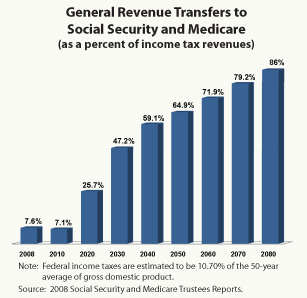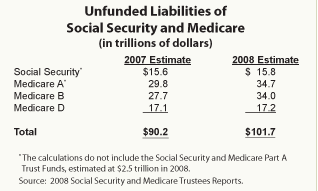The 2008 Social Security and Medicare Trustees Reports show the combined unfunded liability of these two programs has reached $101.7 trillion in today's dollars! That is more than seven times the size of the U.S. economy and 10 times the size of the outstanding national debt. The unfunded liability is the difference between the benefits that have been promised to retirees and what will be collected in dedicated taxes and Medicare premiums. Last year alone, the size of the debt rose by $11.5 trillion. If no other reform is enacted, this funding gap can only be closed in future years by substantial tax increases, large benefit cuts or both.
Social Security versus Medicare. Social Security's projected deficit receives the bulk of attention from politicians and the media, but Medicare's future liabilities are far more ominous. The numbers in the nearby table are especially interesting in light of President Bush's efforts to reform Social Security. Note that:
- Medicare's total unfunded liability is more than five times larger than that of Social Security.
- Further, the Bush administration's newly added prescription drug benefit (Part D) has an unfunded liability greater than Social Security!
 Future Payroll Tax Burdens. Currently, Social Security and Medicare Part A (Hospital Insurance) benefits are funded by a 15.3 percent payroll tax on wages — 12.4 percent for Social Security and 2.9 percent for Medicare. But if payroll tax rates rise to meet unfunded obligations:
Future Payroll Tax Burdens. Currently, Social Security and Medicare Part A (Hospital Insurance) benefits are funded by a 15.3 percent payroll tax on wages — 12.4 percent for Social Security and 2.9 percent for Medicare. But if payroll tax rates rise to meet unfunded obligations:
- When today's college students reach retirement, Social Security alone will require a payroll tax of 16.55 percent, one-third greater than today's rate.
- When Medicare Part A (hospital insurance) is included, the payroll tax burden will rise to 25.25 percent — more than one of every four dollars workers will earn that year.
- If Medicare Parts B and D are included, the burden of Social Security and all of Medicare will climb to 33.6 percent of payroll by 2054 — one in three dollars of taxable payroll, and twice the size of today's payroll tax burden!
Thus, one-third of the wages workers will earn in 2054 will need to be committed to pay benefits promised under current law. That is before any bridges or highways are built and before any teachers' or police officers' salaries are paid.
Impact on the Federal Budget. Until recently, the combined effect of Social Security and Medicare on the rest of the federal government was relatively small. The combined deficits of both programs now require about 8 percent of general income tax revenues [see the figure]. As the baby boomers begin to retire, however, that number will soar, and, as a result, it will be increasingly difficult for the federal government to continue spending on other activities. In the absence of a tax increase, if the federal government keeps its promises to seniors and balances its budget:
- By 2012, the federal government will stop doing 1 in 10 other things it has been doing.
- By 2020, the federal government will stop doing 1 in 4 things.
- By 2030, about the midpoint of the baby boomer retirement years, the federal government will stop doing about 1 in 2 things.
Impact on Federal Revenues. Total health care spending in the United States has historically grown 2.5 percentage points faster than per capita Gross Domestic Product (GDP). In particular, Medicare spending may rise even faster than the Trustees report estimates. According to the Congressional Budget Office (CBO), if Medicare spending continues to grow at the historical growth rate of total health care spending:

- Social Security, Medicare and Medicaid (the health care program for the poor) will consume nearly the entire federal budget by 2050.
- By 2082 Medicare spending alone will consume nearly the entire federal budget.
Can Higher Taxes Solve the Problem? The CBO also found that if federal income tax rates are adjusted to allow the government to continue its current level of activity and balance the budget:
- The lowest marginal tax bracket of 10 percent would have to rise to 26 percent.
- The 25 percent marginal tax bracket would increase to 66 percent.
- The current highest marginal tax bracket (35 percent) would have to rise to 92 percent!
Additionally, the top corporate income tax rate of 35 percent would have to increase to 92 percent.
Pay-As-You-Go. Social Security and Medicare are in trouble precisely because they are based on pay-as-you-go financing. Every dollar of payroll taxes is spent. Nothing is saved, and nothing is invested. The payroll taxes contributed by today's workers pay the benefits of today's retirees. However, when today's workers retire, their benefits will be paid only if the next generation of workers agrees to pay even higher taxes.
What about the Trust Funds? Like other government trust funds (highway, unemployment insurance and so forth), the Social Security and Medicare Trust Funds exist purely for accounting purposes: to keep track of surpluses and deficits in the inflow and outflow of money. The accumulated Social Security surplus actually consists of paper certificates (non-negotiable bonds) kept in a filing cabinet in a government office in West Virginia. These bonds cannot be sold on Wall Street or to foreign investors. They can only be returned to the Treasury. In essence, they are little more than IOUs the government writes to itself.
Every payroll tax check signed by employers is written to the U.S. Treasury. Every Social Security benefit check comes from the U.S. Treasury. The trust funds neither receive money nor disburse it. Moreover, every asset of the trust funds is a liability of the Treasury. Summing over all three agencies (both trust funds and the Treasury), the balance is zero. For the Treasury to write a Social Security check, the government must first tax or borrow.
Conclusion. The Social Security and Medicare deficits are on a course to engulf the entire federal budget. If our policymakers wait to address these growing debts until they are out of control, the solutions will be drastic and painful.
Pamela Villarreal is a policy analyst with the National Center for Policy Analysis.